We’re originally from the Philippines and find Colombian food to be familiar and very comforting.
In many ways, it reminds us of Filipino food which shouldn’t be surprising considering Colombia and the Philippines share similar histories. We were both colonies of Spain for about 300 years and Spanish influence is still very much apparent in our cultures, especially in our respective cuisines.
Empanadas and bandeja paisa are some of our favorites but here are 25 Colombian dishes that you need to try on your next visit to Bogota and Colombia.
FOOD IN COLOMBIA QUICK LINKS
If you’re planning a trip to Colombia and want to really learn about the local cuisine, then you may be interested in joining a Colombian food or wine tour.
TOURS & OTHER SERVICES
- Colombian Food Tours: Food and Wine/Drinking Tours in Colombia
- Colombian Cooking Classes: Cooking Classes in Colombia
- eSIM: Colombia eSIM
Save This on Pinterest!
No time to read this article on Colombian food? Click on the save button and pin it for later!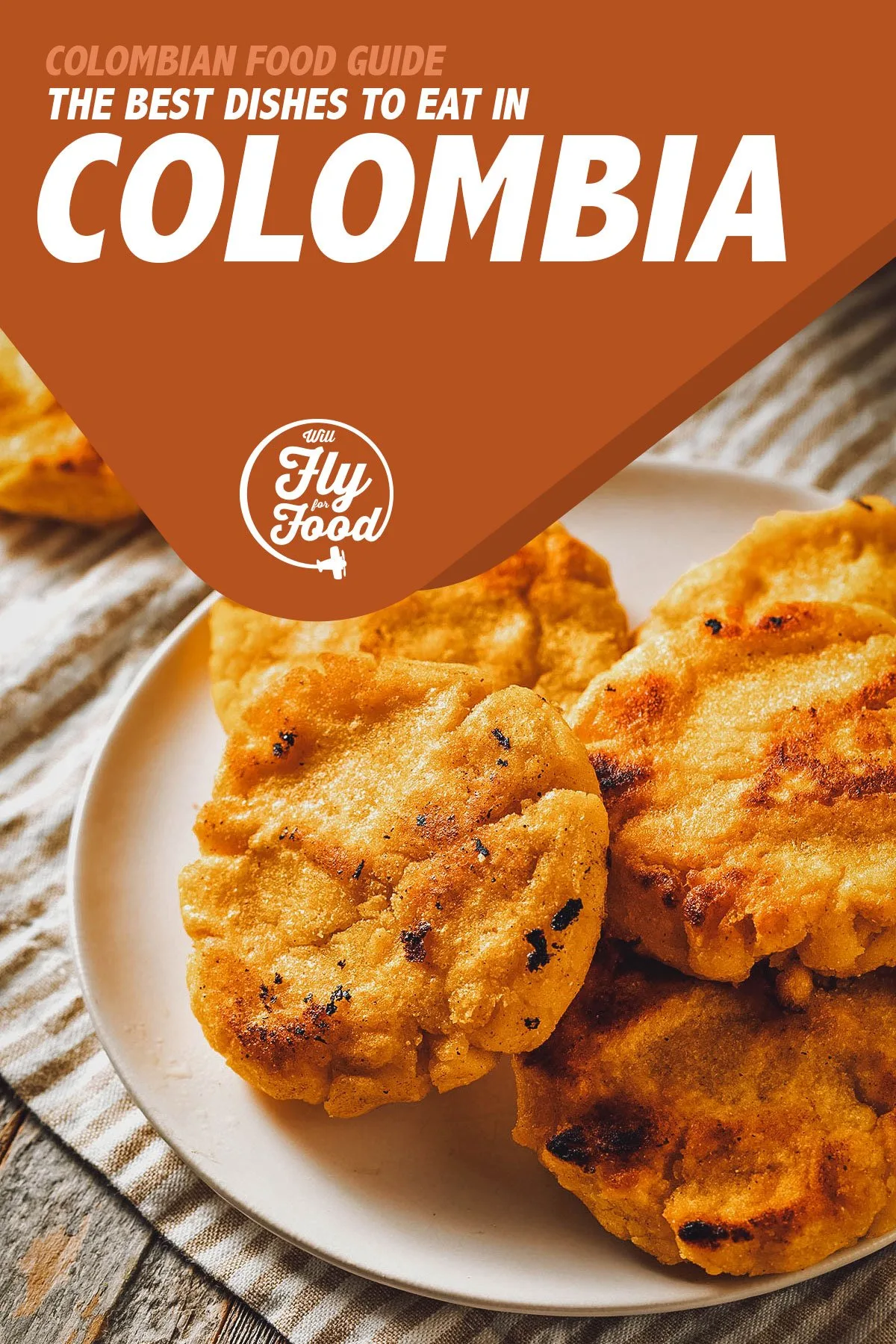
Photo by bhofack2
WHAT IS TRADITIONAL COLOMBIAN CUISINE?
Colombian cuisine is comprised of the culinary traditions of the six main regions of Colombia – the Caribbean, Pacific, Orinoco, Amazon, Andean, and Insular regions. It varies from region to region and can best be described as a mix of native Colombian, Spanish, and African influences. In some parts of Colombia, you can find a distinct Arab influence as well.
The food in Colombia is strongly influenced by local ingredients and the cultural traditions of its ethnic groups, but common ingredients include rice, maize, potato, cassava, and various legumes. Beef, chicken, pork, and goat are commonly consumed proteins as are different types of fish and seafood.
Being a tropical and isothermal country, you’ll find a wide range of tropical fruits in Colombia like lulo, papaya, cape gooseberry, feijoa, guava, and passion fruit. Arepas and patacones are important side dishes while bandeja paisa, sancocho, and ajiaco are widely considered to be national dishes.
MUST-TRY COLOMBIAN DISHES
This Colombian food guide has been organized by category to make it easier to digest. Click on a link to jump to any section of the guide.
SOUPS / STEWS
1. Ajiaco
Ajiaco is a type of chicken soup that’s popular in Colombia, Peru, and Cuba. It’s considered a national dish of Colombia and is especially popular in Bogota, where it’s known as ajiaco santafereño.
Colomban ajiaco is traditionally made with chicken, three varieties of potatoes (papas criollas, sabaneras, and tocarreñas), corn on the cob, and the guascas herb. It’s commonly garnished with capers, avocados, and heavy cream.
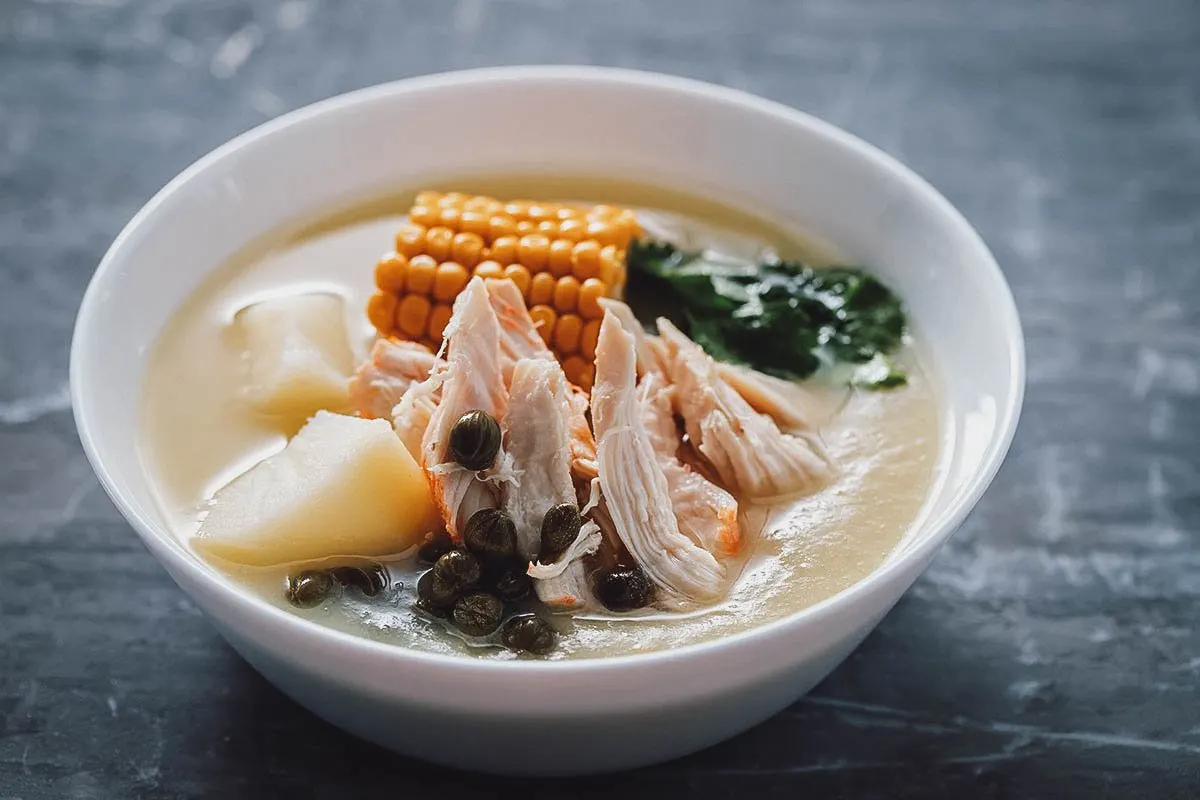
Photo by nataliamylova
2. Sancocho
Sancocho refers to another traditional soup that’s popular in Colombia and other parts of Latin America like Venezuela, the Dominican Republic, Ecuador, Panama, and Honduras. Like ajiaco, it’s considered a national dish of Colombia.
Sancocho can be prepared in different ways but it’s typically made with large chunks of meat, vegetables, and tubers served in a broth. In Colombia, it’s commonly made with chicken, pork or beef ribs, fish, or ox tail.
Depending on the region, Colombian sancocho is made with different tubers and vegetables like potatoes, cassava, plantains, corn on the cob, carrots, and tomatoes. It’s typically garnished with fresh cilantro and lime juice and served with a side of avocados and white rice.
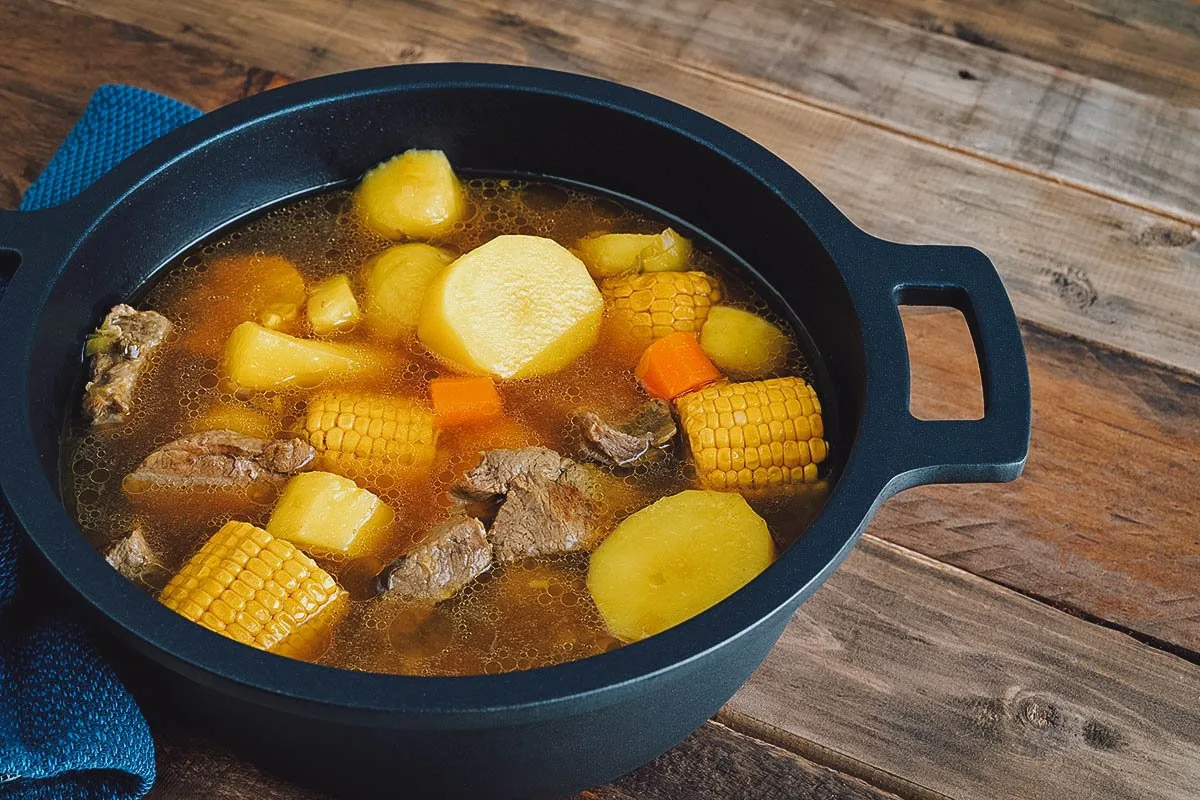
Photo by Maria_Castellanos
3. Cazuela de Mariscos
Cazuela de mariscos is a type of seafood stew that’s popular along the Caribbean coast of Colombia, especially in Cartagena, Barranquilla, and Santa Marta. It’s made with different types of seafood like shrimp, lobster, fish, squid, and clams cooked in coconut milk.
To prepare, vegetables and aromatics like onions, garlic, carrots, and peppers are sauteed in olive oil and butter before being mixed with coconut milk. The different types of seafood are then added to the pot followed by wine and tomato paste. When ready, the stew is often garnished with fresh herbs like cilantro or parsley.
If you’re visiting Cartagena, then be sure to check out our guide on the best restaurants in Cartagena for suggestions on where to try cazuela de mariscos.
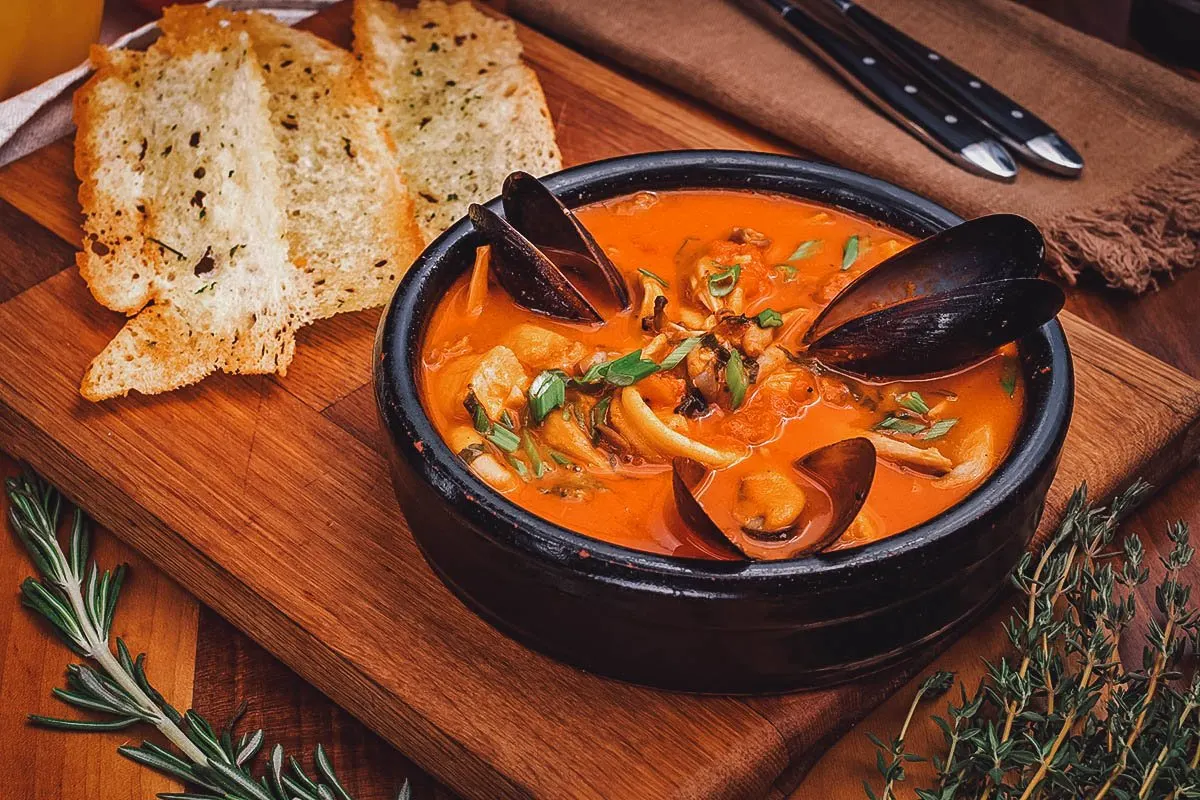
Photo by bbivirys
4. Sopa de Mondongo
Sopa de mondongo refers to a type of tripe soup popular in many countries throughout South America and the Caribbean like Colombia, Puerto Rico, Brazil, and Argentina. It’s made with diced tripe slow-cooked with different vegetables and herbs like onions, garlic, carrots, bell peppers, cabbage, and cilantro.
Sopa de mondongo can be made in different ways depending on where it’s from. In Colombia, it’s typically made with chicken or beef stock, vegetables like carrots, peas, and onions, and lots of cilantro. Beef tripe is most common but in some regions of the country, pork, chicken, and turkey tripe are also used.
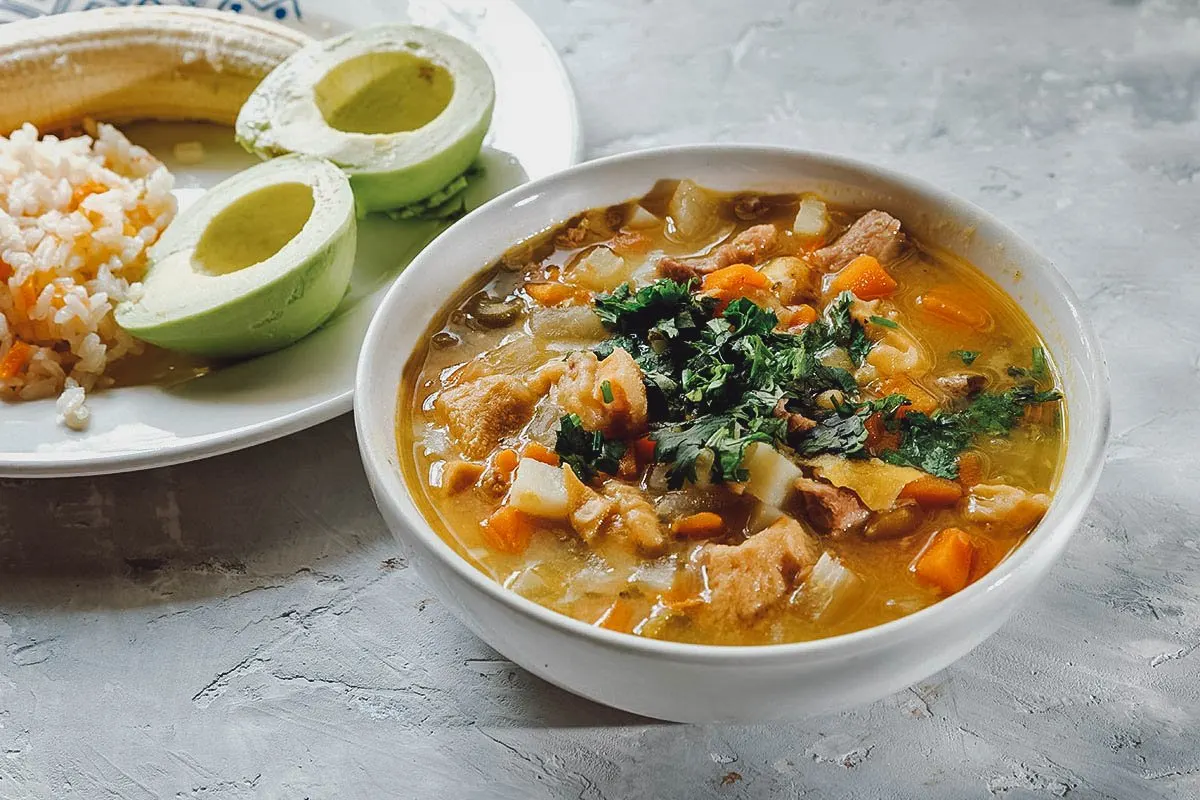
Photo by CUNDO
5. Mote de Queso
Mote de queso is a type of soup that’s commonly consumed in the Caribbean region of Colombia. It’s made with ñame (yams) and queso costeño cooked with onions, scallions, garlic, cumin, tomatoes, and lime.
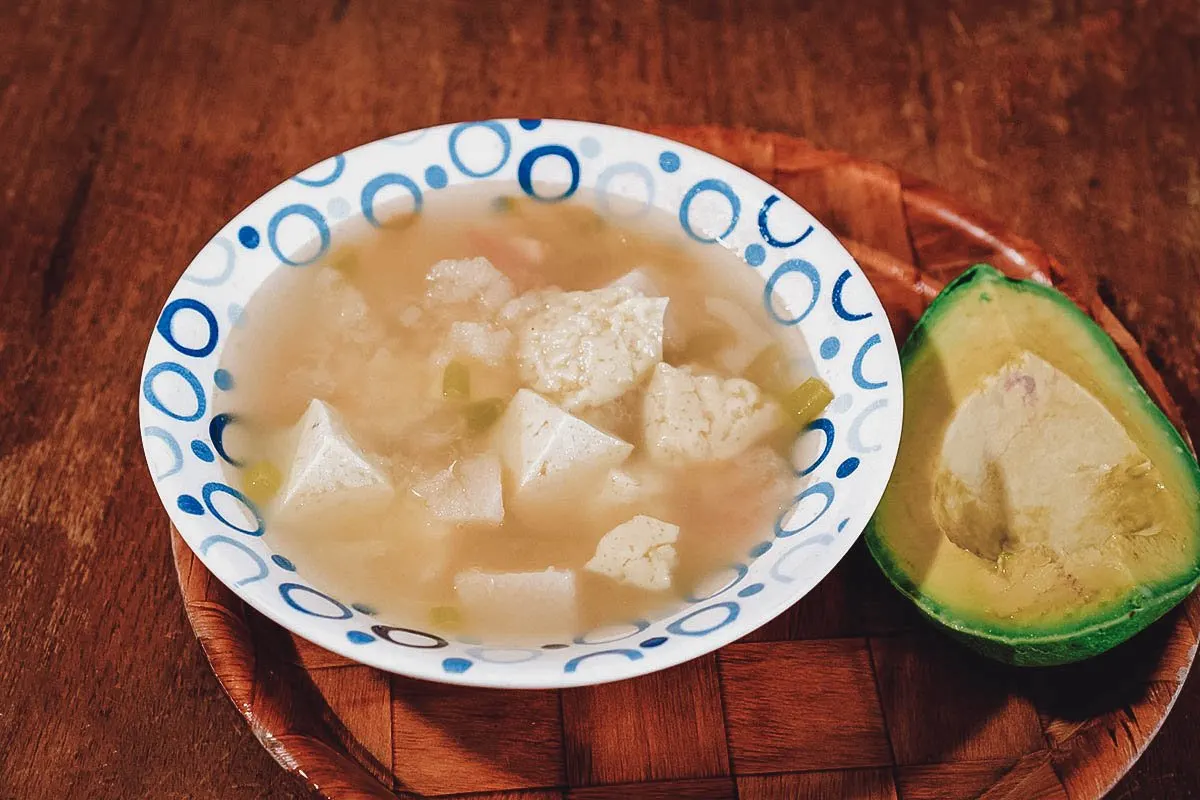
Photo by CUNDO
SIDES / STARTERS / SNACKS
6. Hogao
Hogao refers to a type of sauce commonly used in traditional Colombian cuisine. It’s made with tomatoes and scallions mixed with other ingredients like garlic, cilantro, spices, and seasonings.
Hogao is traditionally used as a base in many recipes or as a dip or topping for Colombian dishes like bandeja paisa, arepas, and patacones. You can think of it as a cooked version of salsa.
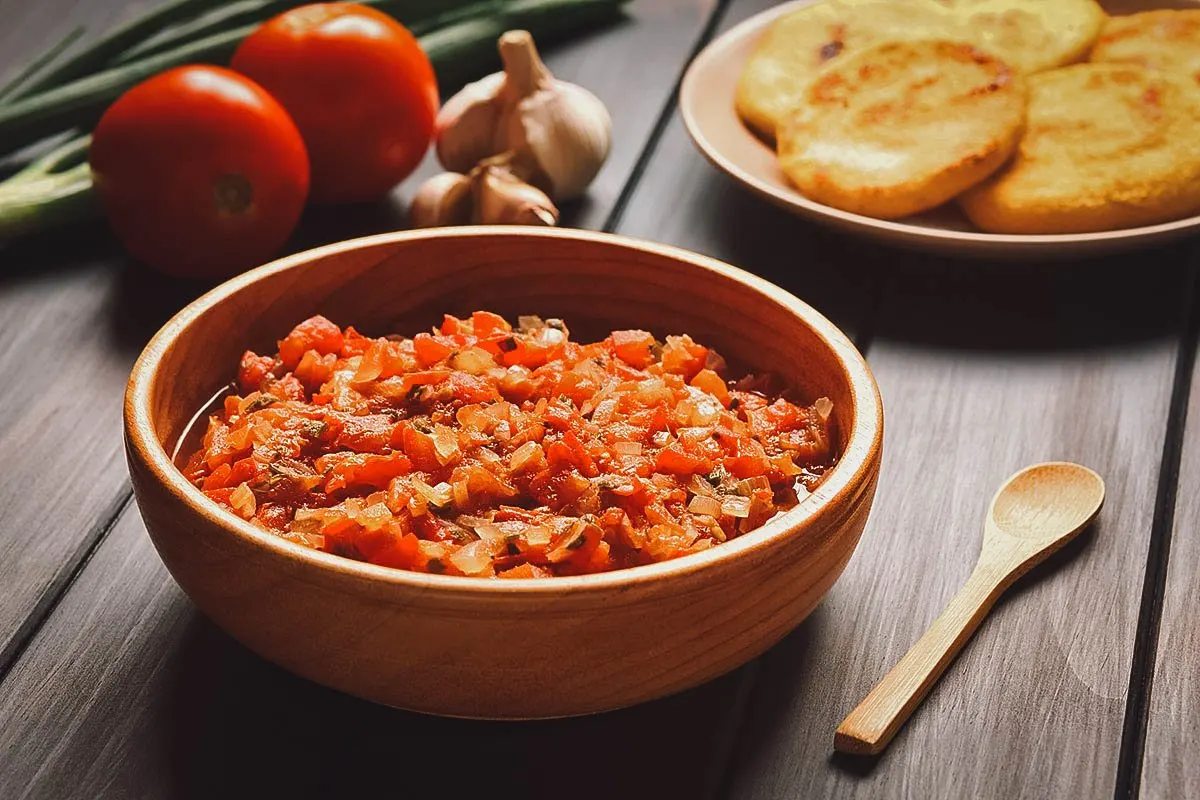
Photo by ildi_papp
7. Empanada
The empanada is the perfect example of Spain’s culinary influence on its former colonies. Believed to have originated in Galicia, empanadas have become an important part of the cuisines of the Philippines and many Latin American countries like Argentina, Venezuela, Chile, Mexico, Bolivia, and El Salvador.
Empanada stems from the Spanish word empanar and literally means “enbreaded” or “coated in bread”. It refers to a baked or fried turnover pastry stuffed with a variety of fillings like ground beef, cheese, corn, and vegetables.
Colombian empanadas are typically made with a dough consisting of ground corn or wheat or corn flour. They can be filled with a variety of ingredients like ground meat with mashed potatoes, pumpkin, cheese, peanuts, and meat or chicken stews with rice and vegetables. They’re relatively small in size and almost always deep-fried.
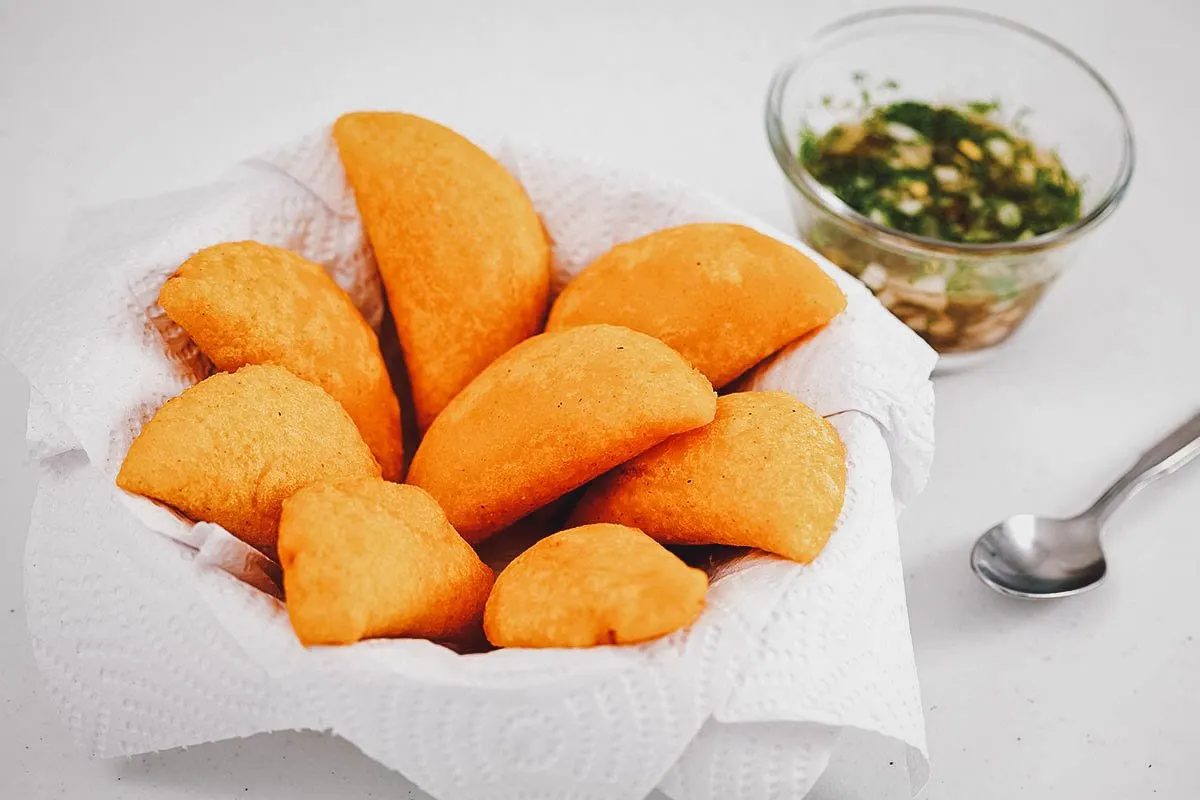
Photo by anamejia18
8. Tamal Tolimense
The tamal is an important dish in the cuisines of many countries throughout Latin America and Colombia is no exception. Tamal tolimense refers to a type of tamal that hails from the Tolima department in the Andean region of Colombia.
Tamales tolimenses are made with a filling of chicken, pork ribs, pork belly, hard-boiled eggs, potatoes, carrots, peas, and rice. The tamal is wrapped in plantain leaves and traditionally eaten for breakfast with chocolate caliente (Colombian hot chocolate) and arepas.
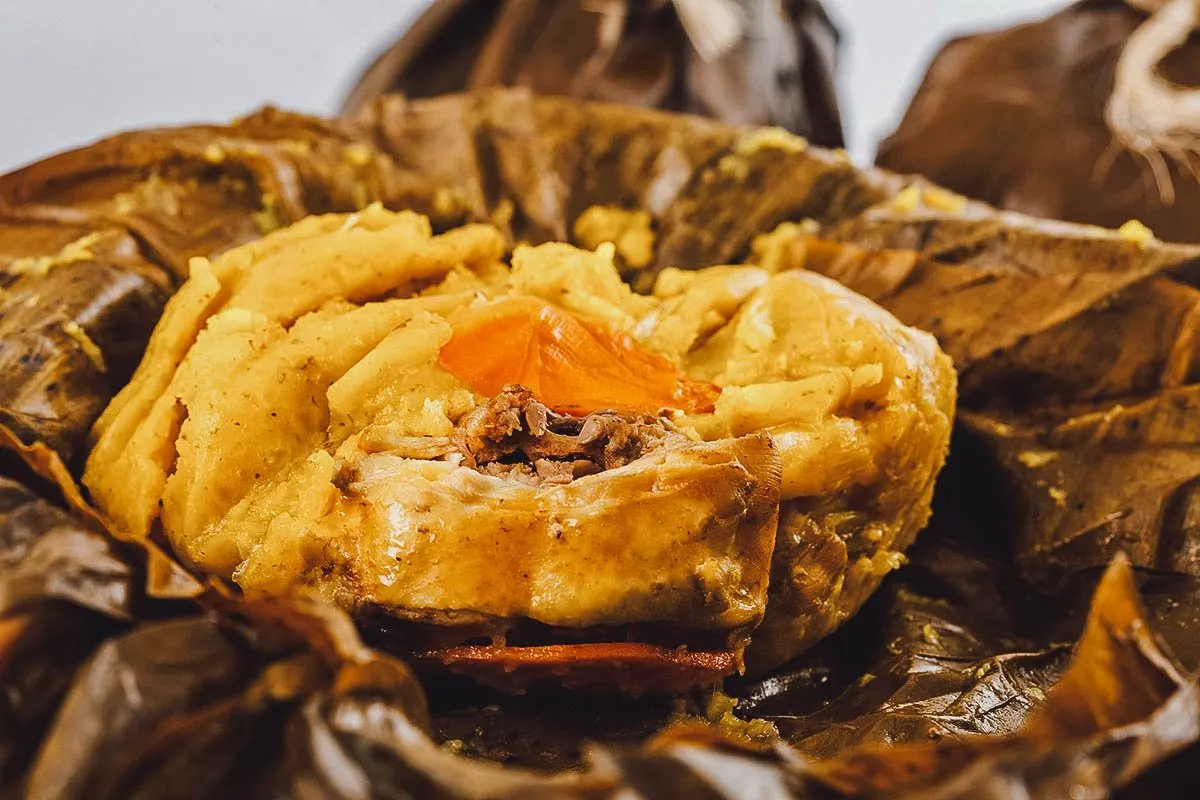
Photo by anamejia18
9. Aborrajados de Platano
Aborrajados de platano refer to a traditional Colombian dish made with deep-fried plantains stuffed with cheese. Typically served as a snack, starter, or side dish, they can also be made with bocadillo or guava paste to go with the cheese.
Aborrajado literally means “battered” and refers to the way the plantains are dipped in batter before being deep-fried.
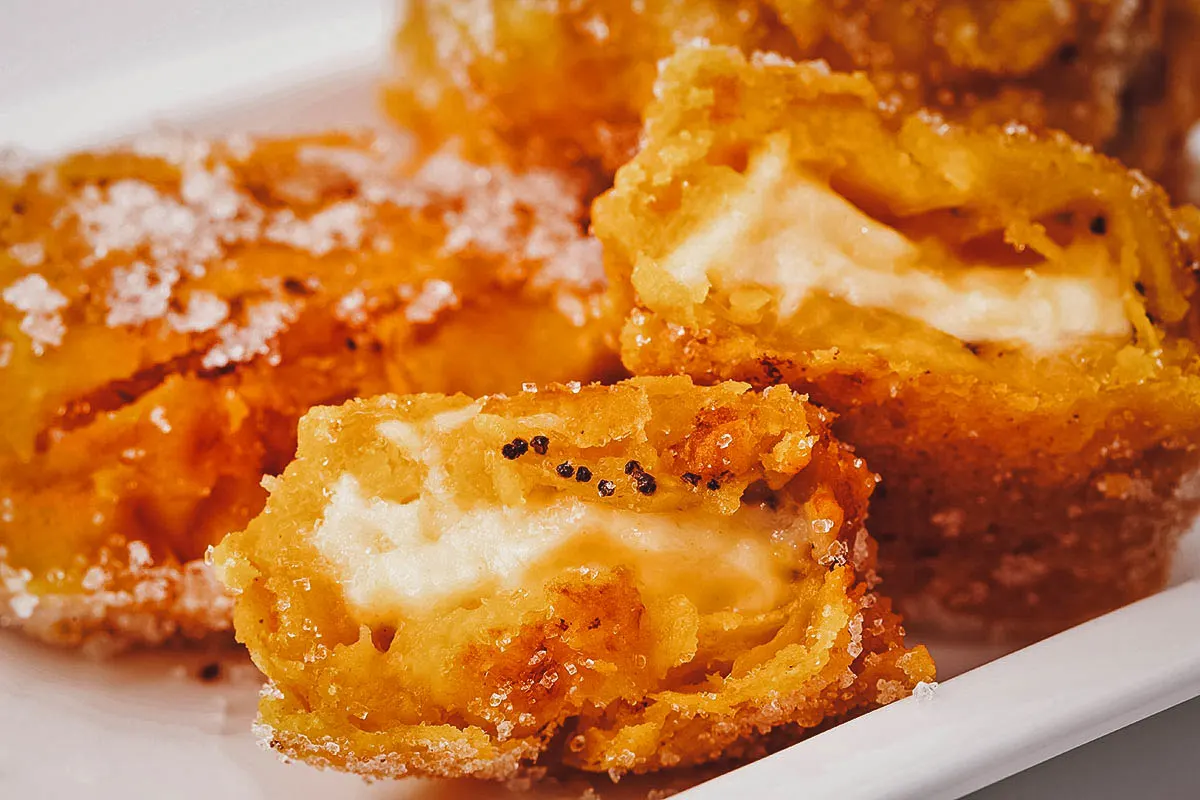
Photo by CUNDO
10. Perro Caliente
Visit Medellin and you’ll find perro caliente stalls throughout the city. Perro caliente literally translates to “hot dog” and refers to the Colombian version of this popular comfort food.
Colombian-style hot dogs are boiled instead of grilled and generously topped with ingredients like coleslaw, pineapple sauce, mayonnaise, ketchup, mustard, and potato chips.
After a night of drinking in Bogota or Medellin, nothing will satisfy your cravings like an overstuffed perro caliente.
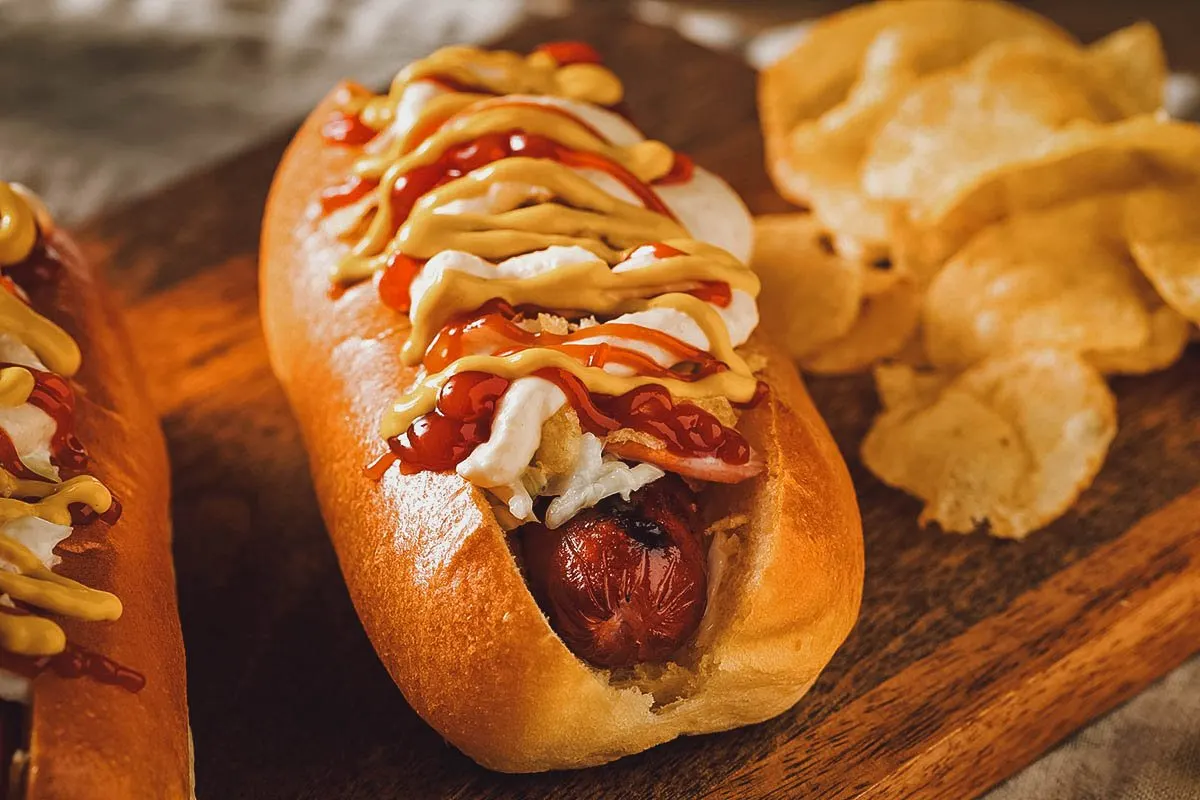
Photo by bhofack2
BREAD / RICE
11. Arepa
Arepas are essentially corn cakes or corn bread made with ground maize dough. It’s especially popular in the cuisines of Venezuela and Colombia where it’s considered a staple dish.
Colombian arepas are known to have at least 42 variants and are commonly eaten throughout the day. Available at street food stalls and restaurants, they can be eaten plain with a dip like hogao or stuffed with various ingredients like meat, eggs, or melted cheese.
In the Caribbean region of Colombia, a stuffed version called arepa de huevo is especially popular. Typically eaten for breakfast, it’s made with an arepa that’s been split open, stuffed with a raw egg, and then deep-fried.
Arepa de huevo is so popular that a festival is held in its honor every year. The small town of Luruaco, credited for inventing arepas de huevo, hosts an annual festival celebrating this delicious deep-fried Colombian treat.
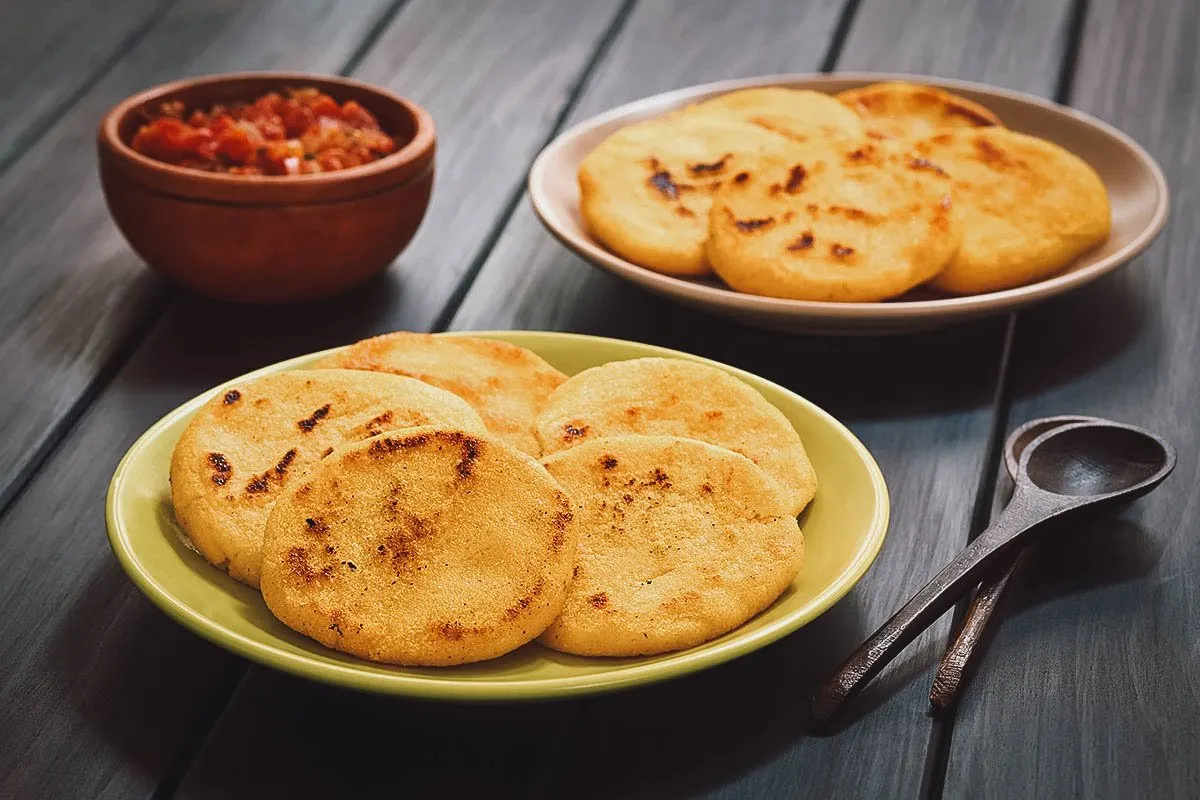
Photo by ildi_papp
12. Almojabana
The almojábana is a type of Colombian cheese bread made with cornmeal and cuajada cheese as its main ingredients. Cuajada cheese is a type of fresh cheese made with non-pasteurized milk.
Almojábanas are typically enjoyed for breakfast or as an afternoon snack with a cup of hot coffee.
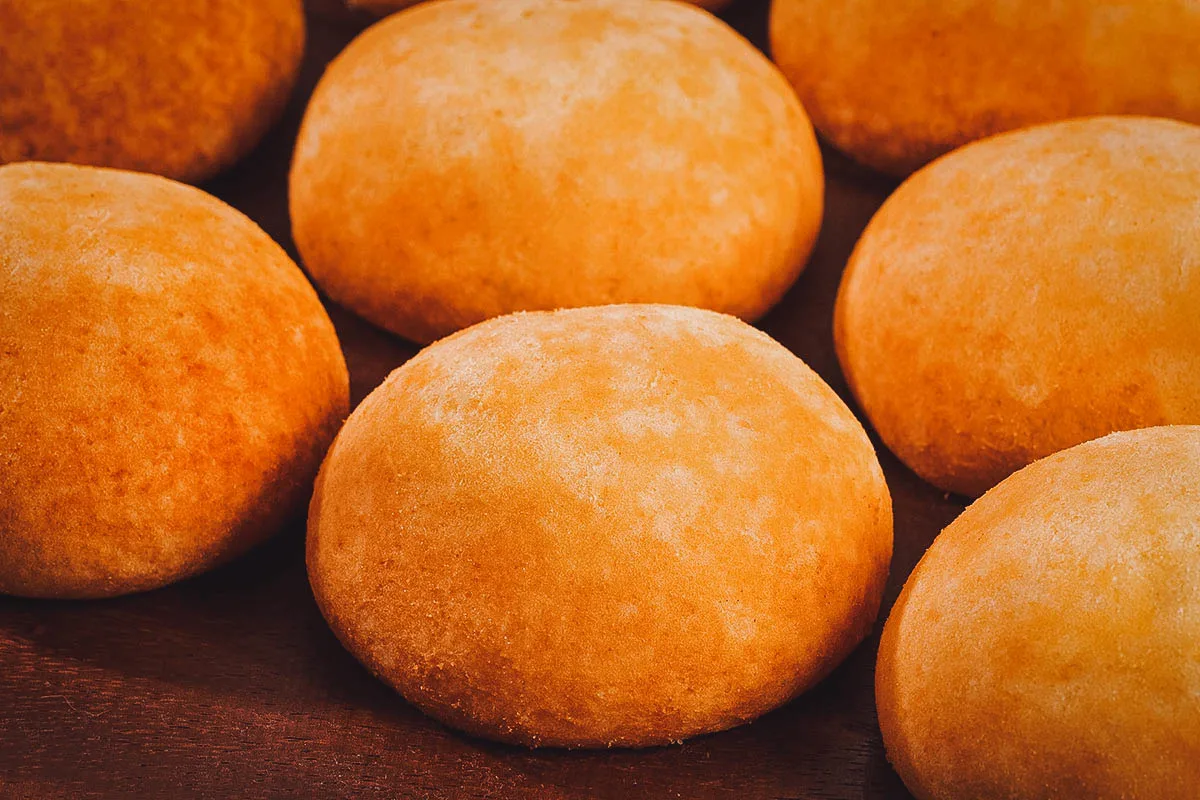
Photo by Luisecheverriurrea
13. Pandebono
Like almojábana, pandebono (or pan de bono) is a type of Colombian cheese bread. It’s made with cassava starch, cheese, and eggs and is traditionally consumed with Colombian hot chocolate. In some parts of the country, it can also be made with guava jam.
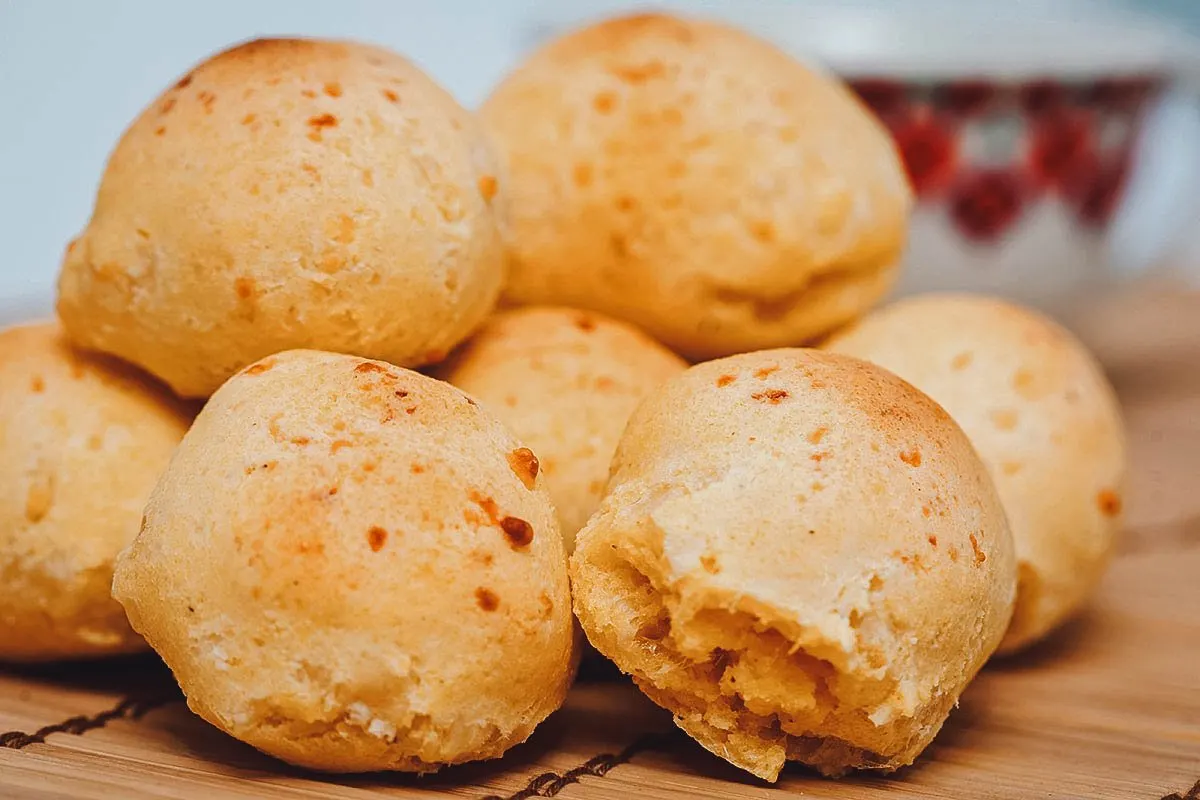
Photo by anamejia18
14. Arroz con Coco (Colombian Coconut Rice)
Arroz con coco translates to “coconut rice” and refers to a rice dish made with white rice cooked in coconut milk. It’s consumed in many countries throughout the Americas, Southeast Asia, and South Asia.
In Colombia, arroz con coco is especially popular in the Caribbean region where it’s typically eaten as a side dish with fish. It’s made by soaking white rice in coconut milk and mixing it with shredded coconut, water, sugar, salt, and raisins.
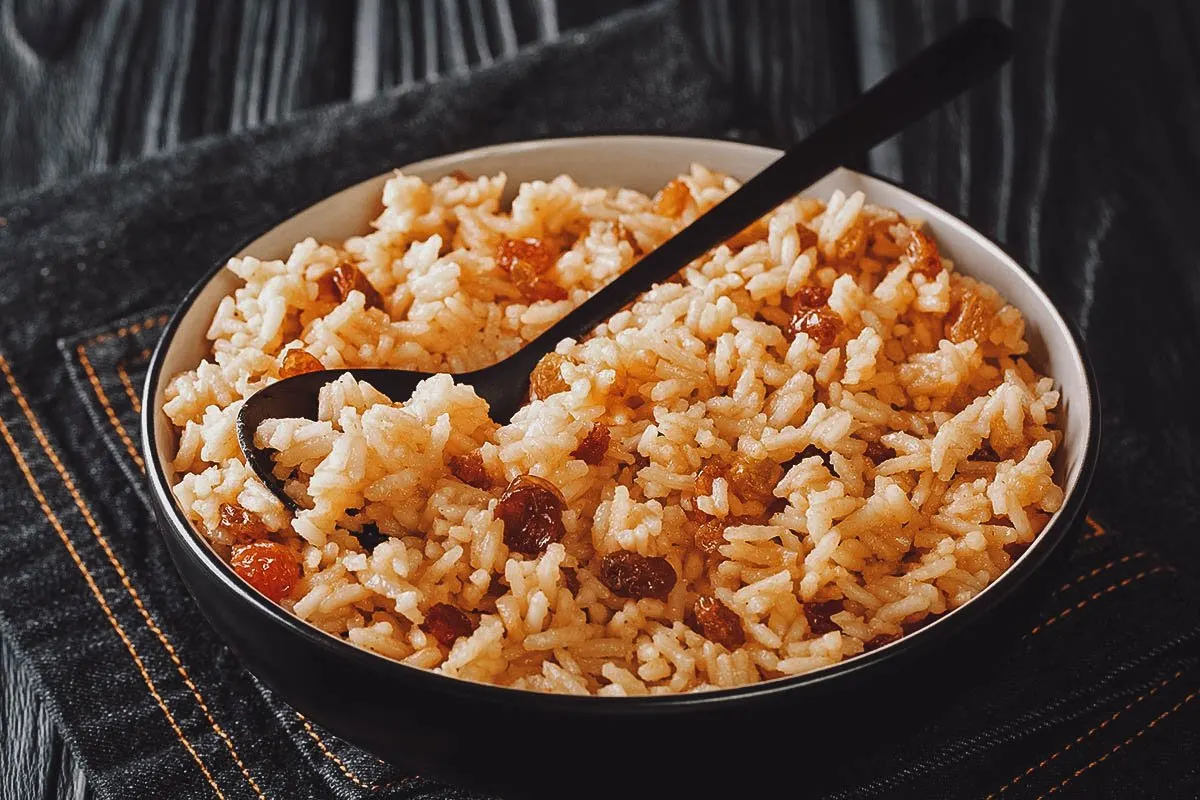
Photo by lenyvavsha
MAINS
15. Ceviche de Camarones (Colombian Shrimp Ceviche)
Ceviche is originally a Peruvian dish that’s become popular throughout the Pacific coastal regions of Latin America and beyond. In Peru, it’s traditionally made with raw white fish cured in citrus juices and aromatics but in Colombia, it’s a little different.
Colombian-style ceviche is made with different types of cooked shellfish dressed with lime juice, ketchup, hot sauce, aromatics, herbs, and seasonings. It’s enjoyed throughout the country though it’s especially popular in the coastal regions of Colombia.
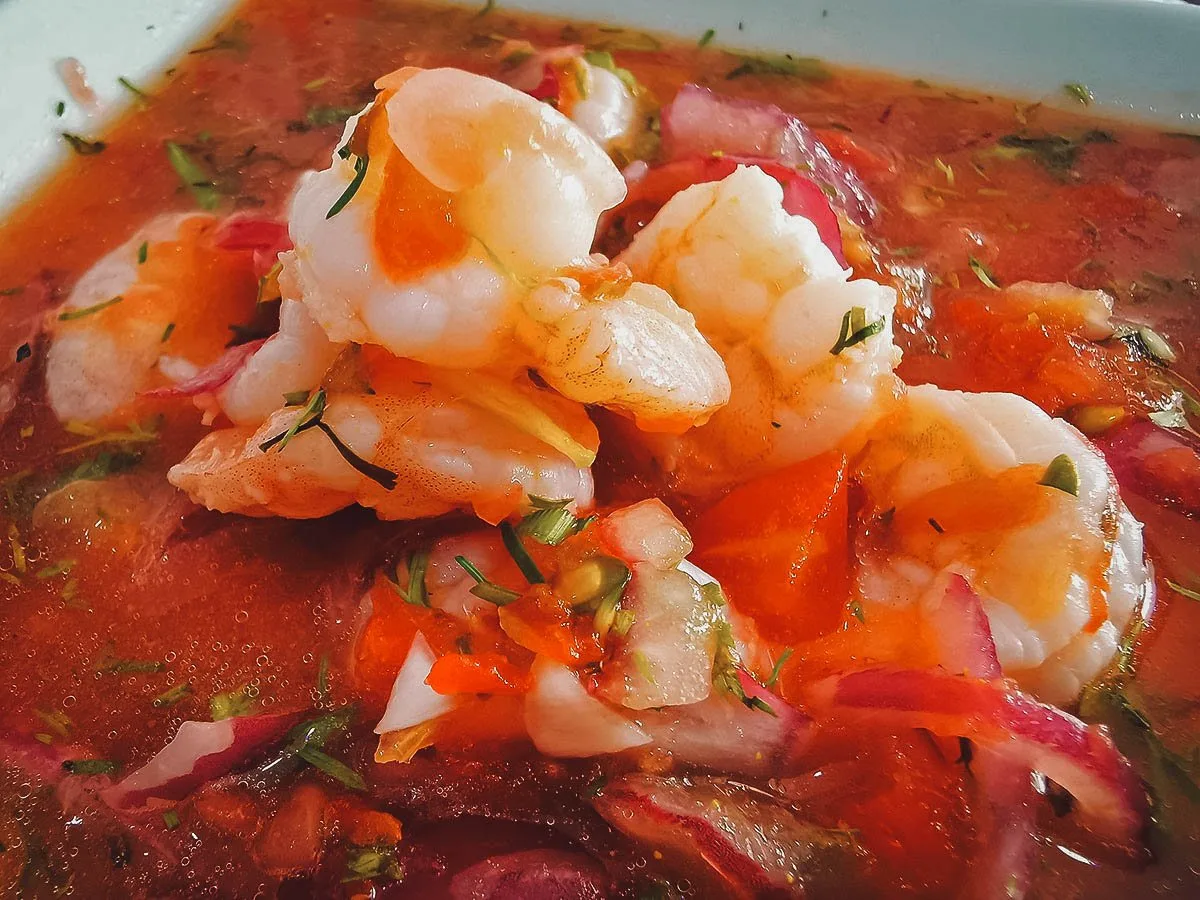
Photo by pxhidalgo
16. Bandeja Paisa
If you’re a big eater, then bandeja paisa will be one of your favorite dishes in Colombian cuisine. It refers to an overflowing platter of food consisting of white rice surrounded by a multitude of different meats and side dishes.
Bandeja paisa varies from region to region but it’s commonly made with dishes like carne molida (ground meat), red beans with pork, chicharron (fried pork rinds), chorizo, morcilla (blood sausage), platano maduro (plantains), arepa, hogao, avocado, and a fried egg. Depending on the region and restaurant, it can be made with other meats as well like steak, grilled pork, chicken breast, and wiener sausages.
Just from looking at the picture below, you can see that bandeja paisa is an immensely filling Colombian dish. Like ajiaco and sancocho, it’s regarded as one of Colombia’s national dishes.
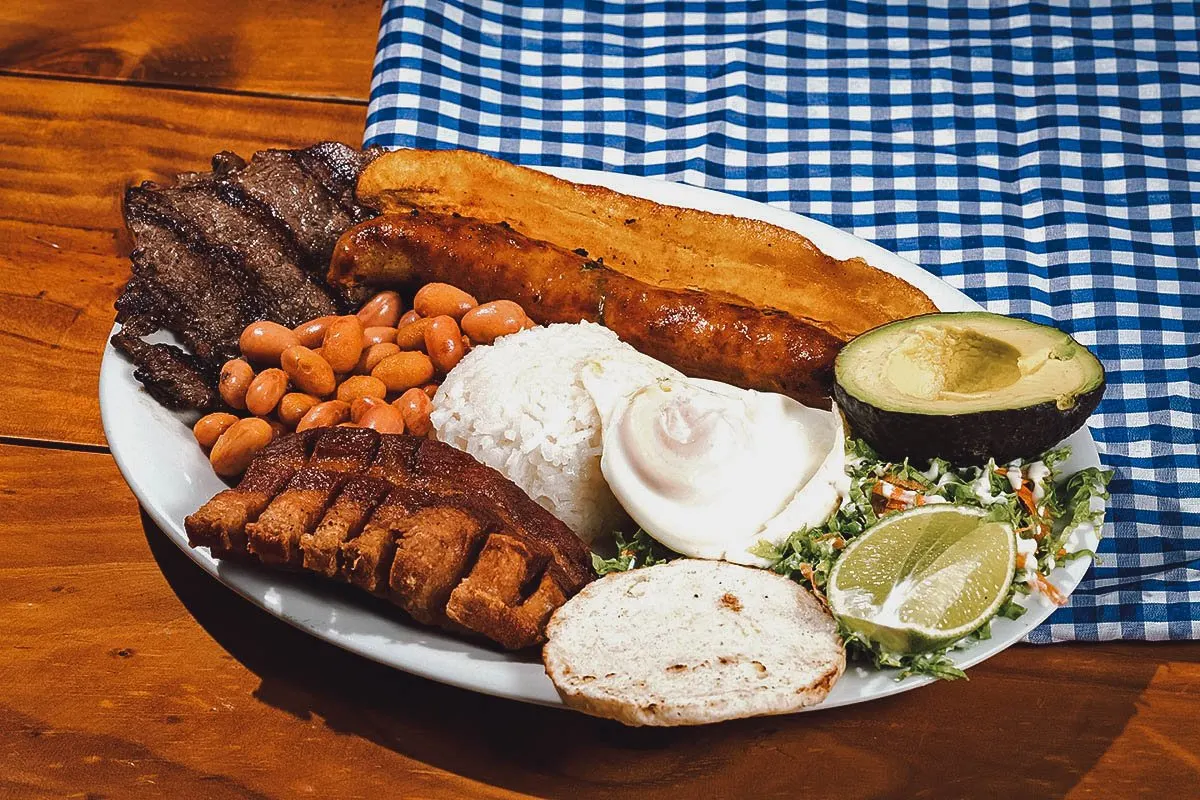
Photo by gonzalocallefotografia.gmail.com
17. Lechona Tolimense
Like tamal tolimense, lechona tolimense is a traditional Colombian dish that hails from the Tolima department of Colombia.
It’s traditionally made with a whole pig stuffed with rice, chunks of pork, peas, spices, and seasonings. The stuffed pig is then baked in an oven for ten to twelve hours, until the skin becomes nice and crispy. When ready, it’s usually served with a side of arepas, potatoes, and lime wedges.
Like many whole pig dishes, lechona is typically reserved for holidays and special occasions. Though it traditionally calls for a whole pig, smaller versions can be made with stuffed slabs of pork fatback (pictured below).
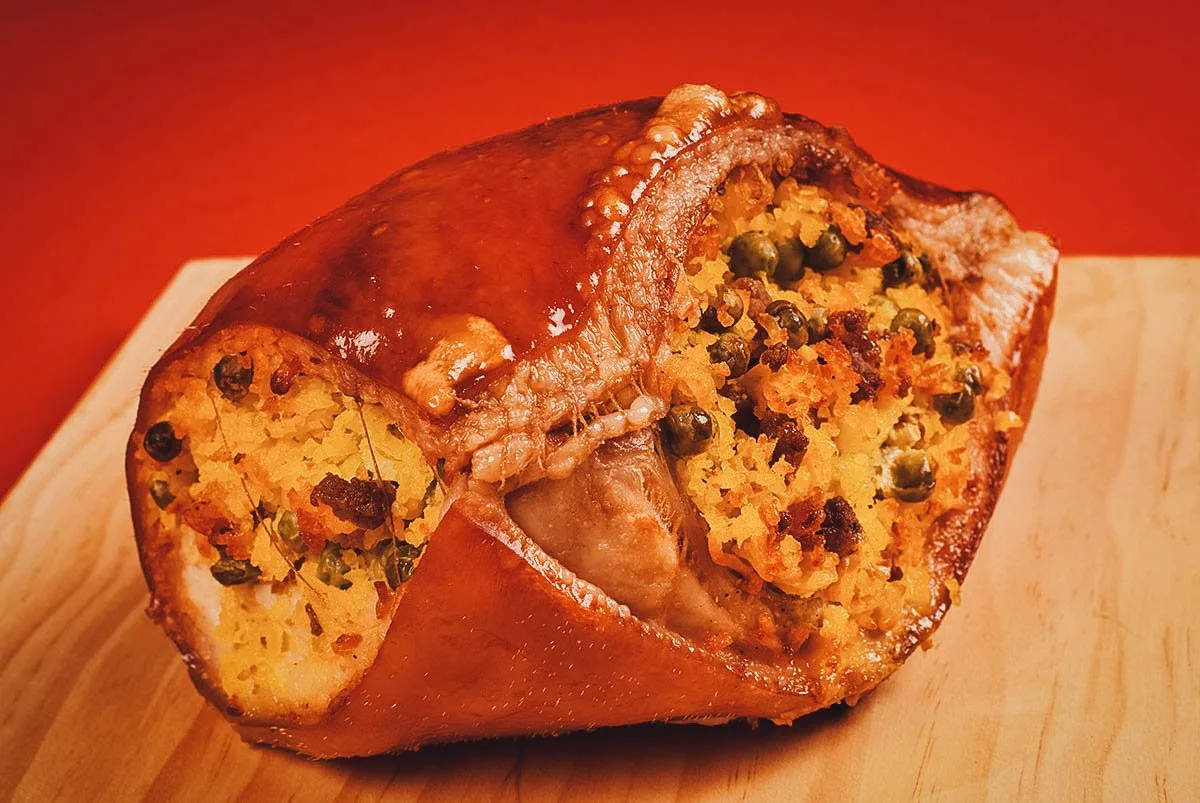
Photo by OlafSpeier
18. Carne Oreada
Carne oreada refers to a traditional Colombian meat dish made with sun-dried, salted beef. Thin slices of dry, cured beef are grilled with oil and served with various side dishes like arepas, yucca, and potatoes.
Carne oreada is a specialty of Santander, a north-central Colombian department in the Andes mountains. At the time, refrigeration wasn’t available so people preserved meat by curing it with salt, lime, and beer before leaving it out in the sun to dry.
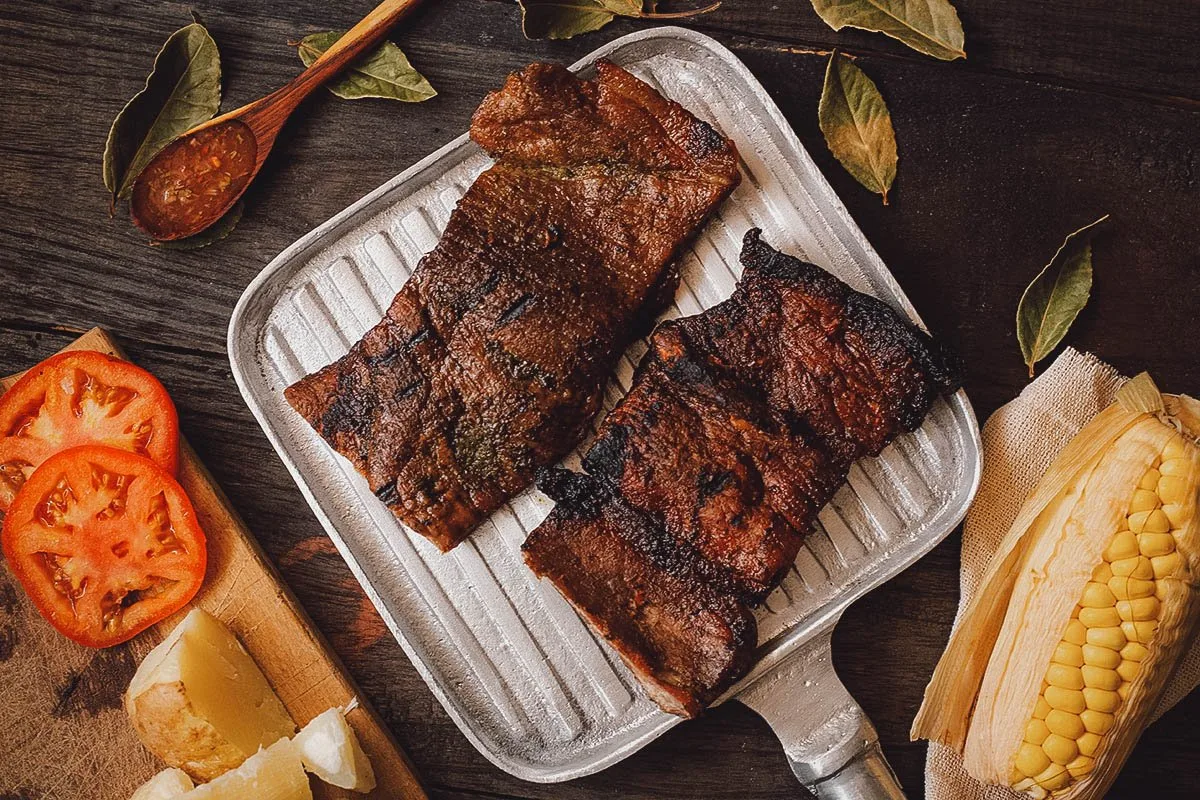
Photo by FotoRojas
DESSERTS
19. Obleas
Obleas are wafer desserts popular in Spain and Latin America. Traditionally, it consists of two communion wafers held together with dulce de leche, but it can also be made with other fillings and toppings like cheese, jam, fruits, whipped cream, chocolate, and coconut.
The term oblea stems from the Low Latin oblata, meaning “offering” or “bread offered to the Eucharist”.
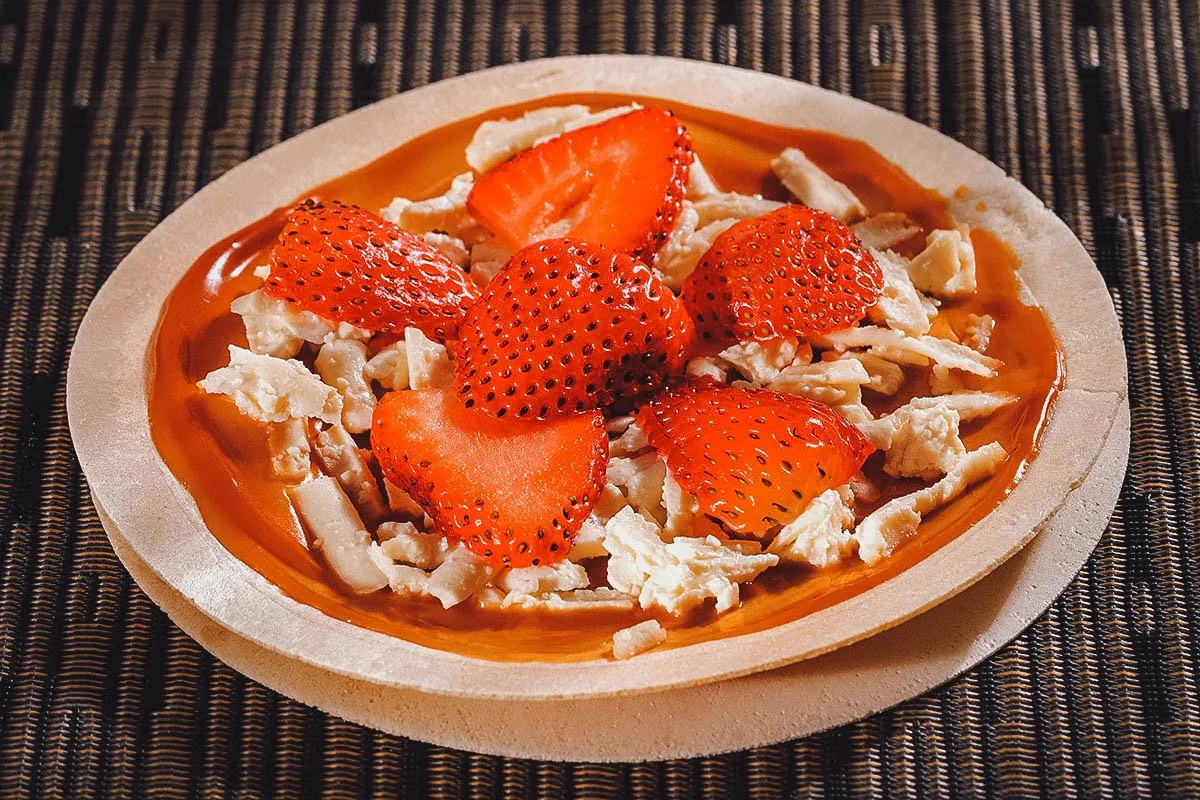
Photo by Luisecheverriurrea
20. Cholado
Cholado refers to a refreshing Colombian iced dessert popular in the Valle del Cauca department of Colombia. It’s made with crushed or shaved ice, chunks of fresh fruit, fruit syrup, and sweetened condensed milk.
Depending on the vendor, cholado can be served with additional ingredients as well like shredded cheese, grated coconut, whipped cream, and a wafer cookie.
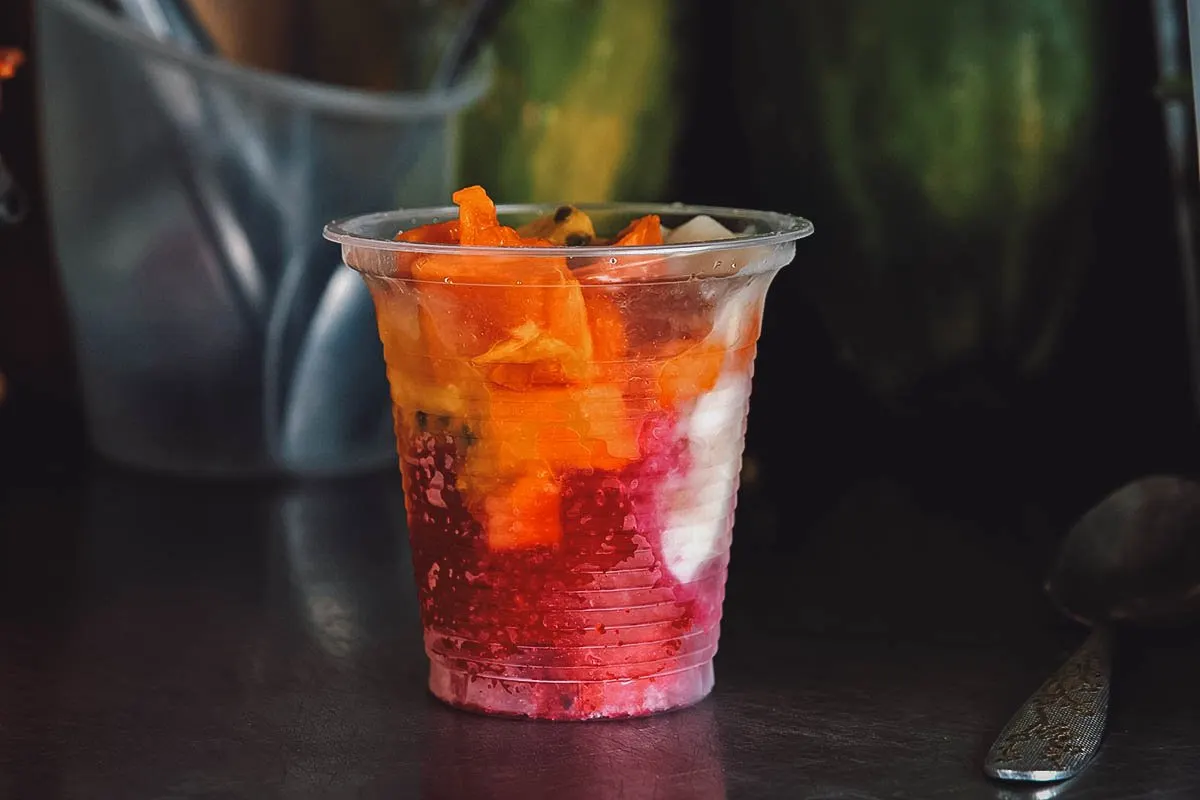
Photo by anamejia18
21. Mazamorra Antioqueña
Mazamorra is a traditional dessert drink from Colombia’s Andean region. It consists of white hominy that’s been cooked until very soft and then served with milk and a side of panela (unrefined whole cane sugar) or guava paste.
Mazamorra Antioqueña refers to a version of mazamorra that’s hugely popular in the Antioquia department of Colombia. It’s made with cracked dry yellow corn instead of hominy.
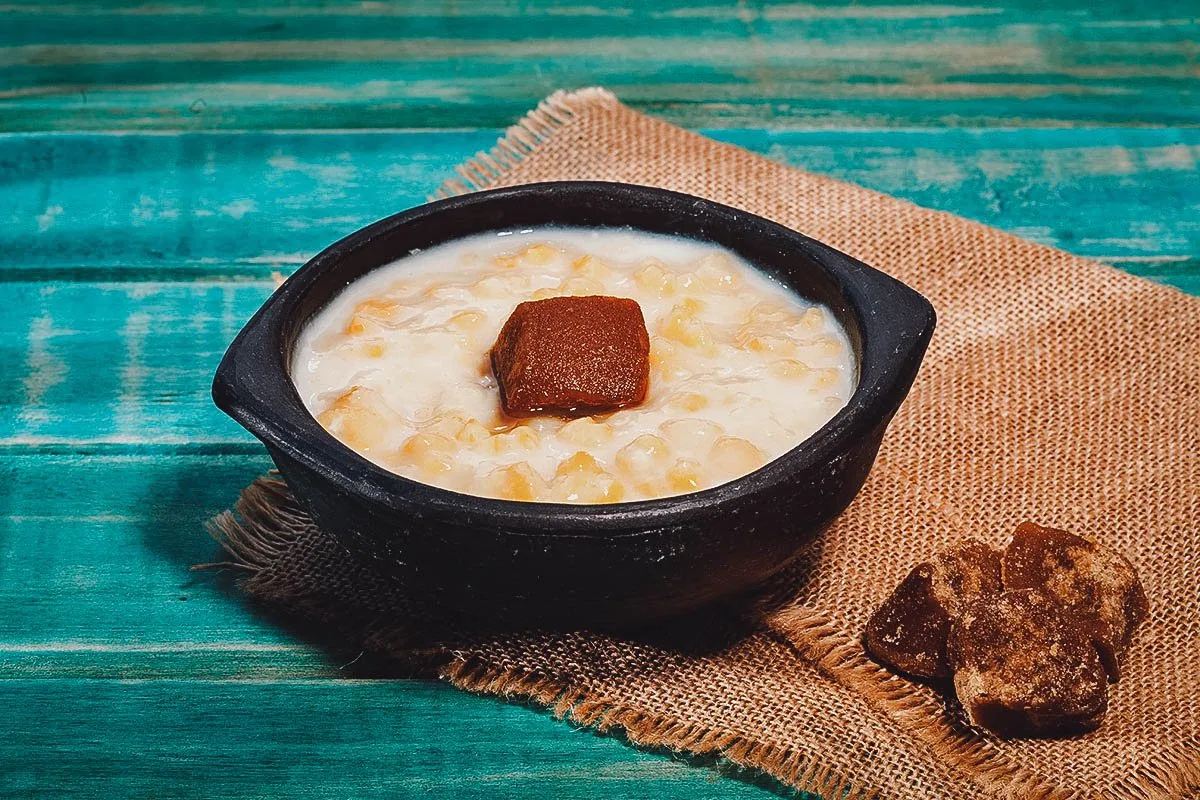
Photo by gonzalocallefotografia.gmail.com
22. Bocadillo
Bocadillo refers to a guava jelly or guava paste dessert made with guava pulp and panela. It’s popular in many countries throughout Central and South America like Colombia, Venezuela, Panama, and Costa Rica.
Guava paste is made with fresh guava that’s mashed into a pulp and strained before being boiled in water with panela. The thickened mixture is then left to cool and molded into blocks.
Bocadillo can be enjoyed on its own, paired with dishes and desserts like mazamorra and aborrajados, or eaten as a spread on bread, often with cheese.
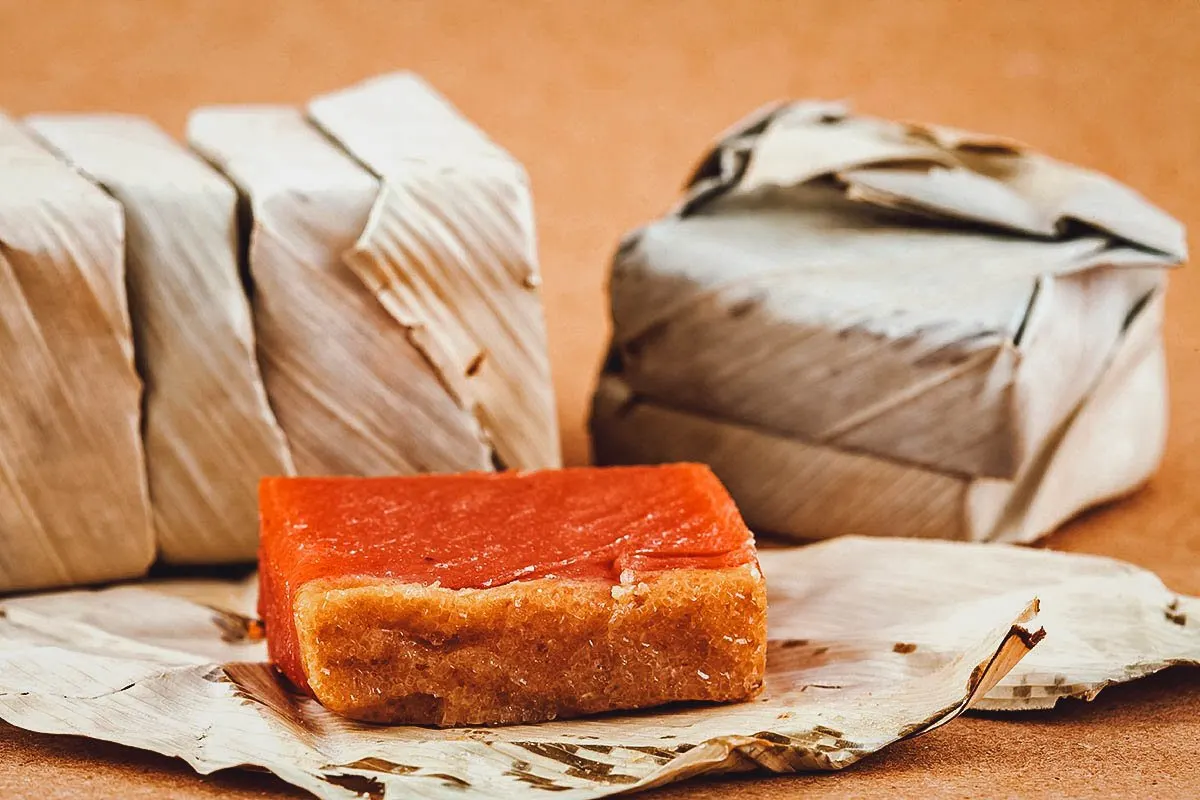
Photo by anamejia18
DRINKS
23. Jugo de Lulo (Lulo Juice)
Jugo de lulo literally means “lulo juice” and refers to a refreshing drink made from a tropical South American fruit known as lulos or naranjillas. They resemble tomatoes and are known for having a citrusy flavor that’s reminiscent of rhubarb and lime.
Lulos are used to make different Colombian dishes and drinks like lulo ice cream, esponjado de lulo (lulo mousse), lulada, and champús, but one of the most common ways to use it is to make lulo juice.
Made with fresh lulos, water, and sugar, jugo de lulo is a refreshing drink that’s purported to have many health benefits.
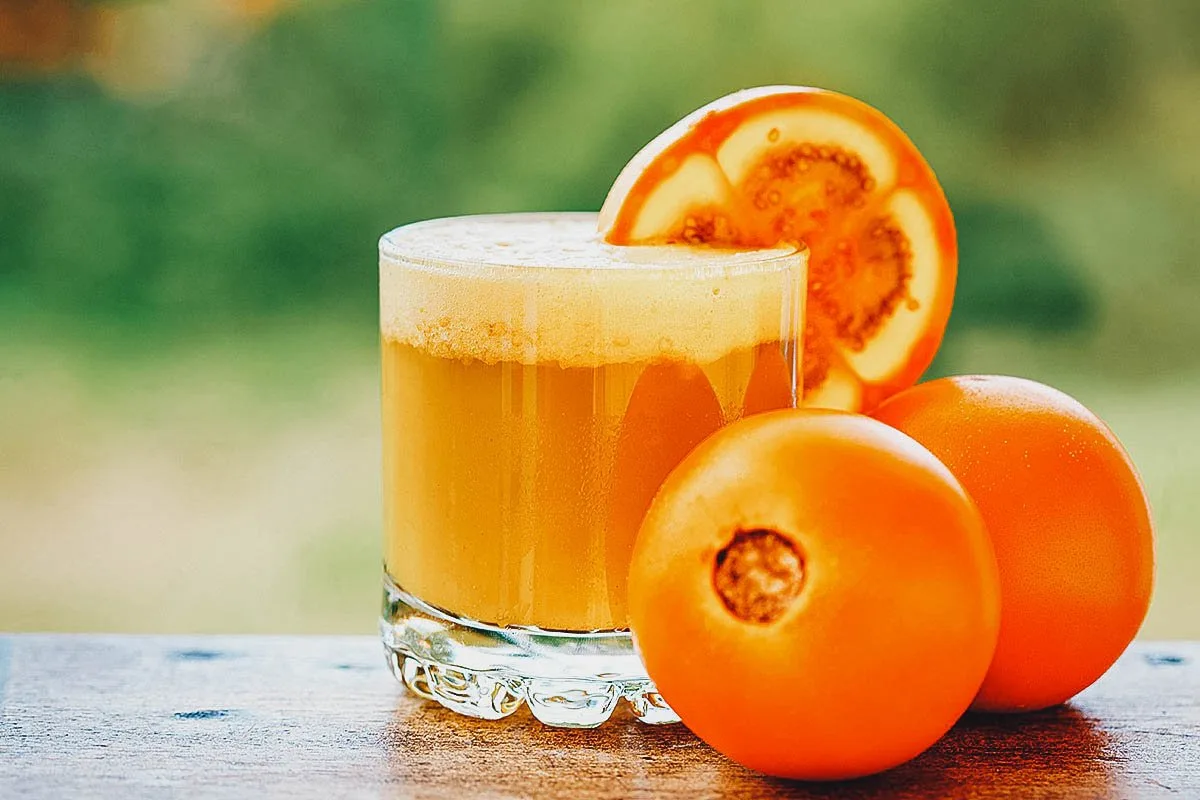
Photo by anamejia18
24. Chocolate Santafreño (Colombian Hot Chocolate)
Colombia is one of the birthplaces of cacao so it’s no surprise that hot chocolate is a popular drink. Also known as chocolate completo, chocolate santafreño is a Colombian hot chocolate drink that’s popular throughout the country, but especially in the capital of Bogota.
Chocolate santafreño is made with pastillas (blocks) of chocolate containing cloves and cinnamon. They’re broken into pieces and then added to milk or water in an aluminum pot called a chocolatera. The mixture is then whisked into a foamy concoction using a wooden instrument called a bolinillo (or molinillo).
What makes chocolate santrafreño different from the usual hot chocolate is that it’s mixed with a mildly salty white cheese called queso campesino before serving.
Colombian hot chocolate is often enjoyed for breakfast with arepas or as an afternoon snack with pan de yucca or almojábanas.
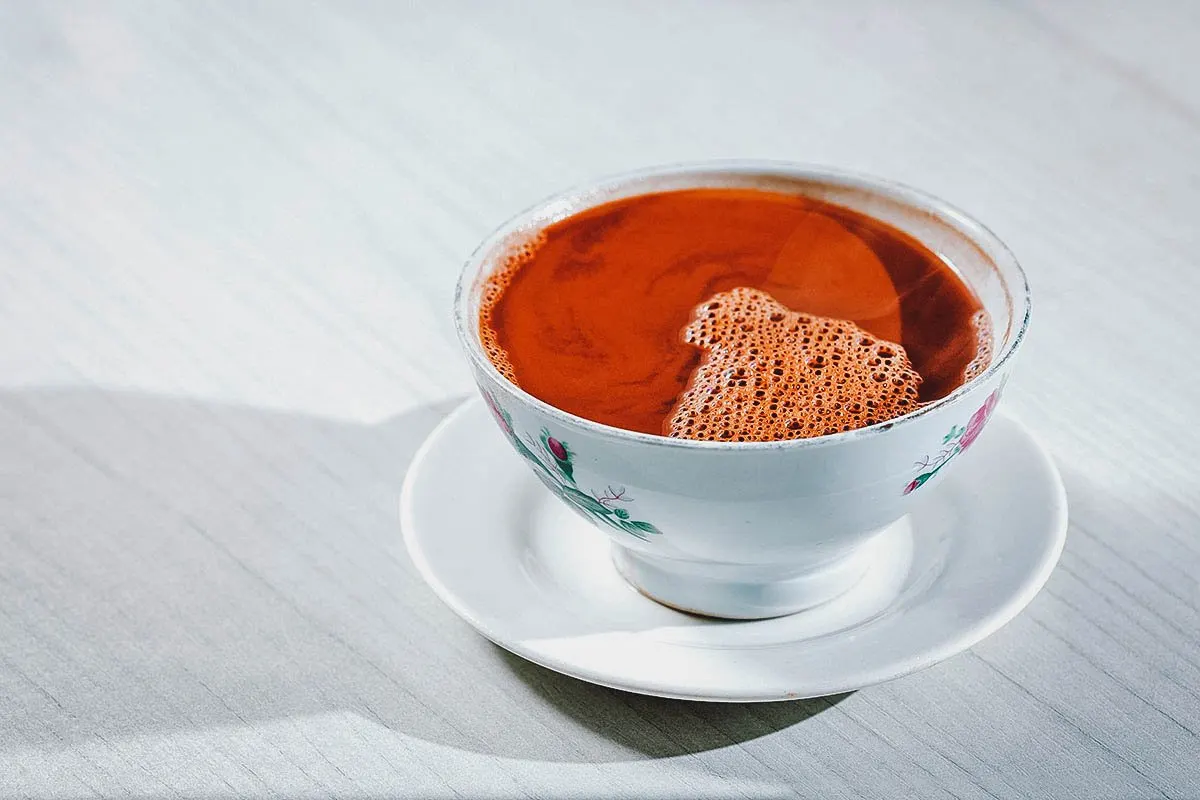
Photo by Luisecheverriurrea
25. Cafe Colombiano
If coffee runs through your veins, then Colombian coffee is no stranger to you. Thanks to its climate and high altitude, Colombia has long held a reputation for being one of the best and most prolific coffee-producing countries in the world. It’s the third-largest producer of coffee behind only Brazil and Vietnam.
Famous worldwide, Colombian coffee tends to fetch a higher price because it consists mostly of higher quality arabica beans as opposed to the lower quality robusta produced by inferior coffee-producing countries.
Depending on where the beans are grown, coffee in Colombia can vary greatly in flavor. On some mornings, you may want a cup of joe that’s bold, nutty, and chocolatey in flavor while on others, you may prefer blends that are lighter, fruitier, and more floral. The choice is yours.

Photo by belchonock
COLOMBIAN FOOD TOURS
It’s easy enough to eat your way through any city, but if you want to go where the locals go, then you may want to join a food tour. Simply put, no one knows Colombian food better than a Colombian, so what better way to experience the local cuisine than with a food-obsessed local?
Not only can a knowledgeable guide take you to the city’s best restaurants, markets, and street food stalls, but they’ll be able to explain all the dishes to you in more detail as well. Check out Get Your Guide for a list of food tours in Colombia.
COLOMBIAN COOKING CLASSES
Going on a food tour takes you to a city’s best eateries, but if you want to really dive into the local cuisine, then you may want to take a cooking class. Eating Colombian dishes like arepas and ajiaco is one thing, but learning how to make them yourself is another. As I like to say, taking a cooking class is like looking under the cuisine’s hood.
If you’re adept in the kitchen and want to learn more about Colombian food, then check out Cookly for a list of cooking classes in Colombia.
FINAL THOUGHTS ON COLOMBIAN CUISINE
As with all our food guides, this article on Colombian food presents just a small taste of all the delicious traditional dishes that the local cuisine has to offer. It’s hardly a definitive list but I hope it whets your appetite and gets you even more excited to visit Bogota, Medellin, or any other city in Colombia.
Colombian food is comforting and filling and will be an excellent companion on your journey through this beautiful country in South America. Thanks for reading and have an amazing time eating your way through Colombia!
Disclosure
Some of the links in this Colombian food guide are affiliate links, meaning we’ll get a small commission if you make a booking at no additional cost to you. As always, we only recommend products and services that we use ourselves and firmly believe in. We really appreciate your support as it helps us make more of these free travel and food guides. Thank you!
Cover photo by alexat25. Stock images via Depositphotos.


Ben
Saturday 10th of December 2022
Found your Blog. I'm glad I got to be a part of your Colombian food experience. Safe travels.
JB & Renée
Sunday 11th of December 2022
It was great meeting you Ben! Hope you enjoyed Cartagena. All the best.
Andrew
Wednesday 14th of September 2022
Your comparing Colombian food to the soy and magic sarap crap they produce in Philippines, you must be out of your mind. Most Filipino food is a substandard version of their America & Spanish counterpart.
JB & Renée
Thursday 15th of September 2022
Well, that might be true, if you're the type of person that can only afford to eat at carinderias in the Philippines.